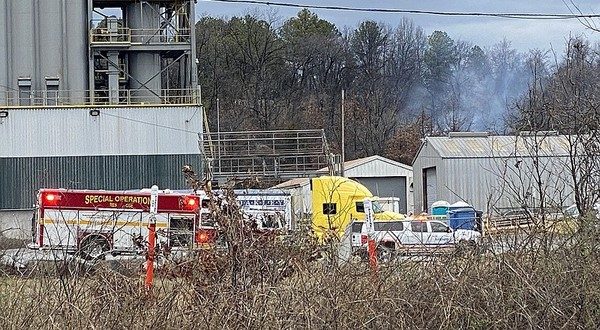
Emergency personnel from various agencies, including the Little Rock Fire Department, respond to the scene of a fatal plane crash on Feb. 22 near the 3M plant in Little Rock. (Photo courtesy of Arkansas Democrat-Gazette)
A preliminary report released Friday by the National Transportation Safety Board detailing the investigation into the Little Rock plane crash last month that killed five people disclosed that three wind shear warnings were issued before the plane took off.
The five-page report also said investigators found no apparent pre-crash mechanical or airframe problems in the plane’s remains.
The incident occurred at 11:56 a.m. on Feb. 22 after a 1986 model Beech B200 twin-engine aircraft, N55PC, took off from runway 18 at Bill and Hillary Clinton National Airport/Adams Field. It carried a pilot, four passengers and equipment bound for John Glenn Columbus International Airport in Ohio and crashed near the 3M plant about a mile south of the airport.
According to the report, at 11:51:16, the pilot requested taxi clearance with Automatic Terminal Information Service, which included a Low Level Wind Shear advisory alert. Seventeen seconds later, ground air traffic control cleared the plane to taxi to runway 18 via taxiway “Alpha.”
At 11:53:07, tower air traffic control transmitted another Low Level Wind Shear advisory alert. At 11:53:21, ground air traffic control transmitted another Low Level Wind Shear advisory alert.
A Low Level Wind Shear Alert System is a ground-based system used to detect wind shear, microbursts and other weather phenomena close to airports, according to the FAA. It provides real-time warnings to pilots.
Low level wind shear is defined as a sudden change of wind velocity and/or direction, and can present risks to flight safety.
At 11:54:47, the pilot requested takeoff clearance from runway 18 on the tower frequency. Eight seconds later, tower air traffic control cleared the pilot for takeoff. At 11:55:06, the pilot acknowledged the takeoff clearance. There were no other transmissions from the pilot after takeoff, and no distress calls were heard from the pilot on any frequency.
The report includes two weather advisories from the airport. The first, from 11:53 a.m., reported wind from 210° at 19 knots with gusts to 27 knots. The second, at 12:02 p.m., reported wind from 300° at 22 knots with gusts to 40 knots, plus light rain and a visibility of two statute miles.
The report cited video from a surveillance camera that was located on the ramp perpendicular to runway 18.
It showed the plane take off and begin an initial climb to the south. The takeoff and initial climb appeared normal, but as the airplane went out of sight, the camera caught a rising plume of smoke about a mile south of the departure end of runway 18. Shortly after the plume of smoke, the camera appeared to shake from wind, and recorded blowing debris and heavy rain on the ramp where the camera was located.
The NTSB said that the investigation of the plane’s remains had found that no “pre-impact airframe anomalies were identified,” that “examinations of the engines did not reveal any pre-impact anomalies” and “both propeller assemblies did not show any pre-impact anomalies.”
Another surveillance camera, located at the 3M plant, witnessed the plane’s impact.
The report said the plane impacted the ground in a “right-wing-low, nose down attitude.”
Heavy rain and blowing debris were captured near the crash site.
The victims of the plane crash were employees of North Little Rock-based environmental consultancy firm CTEH — Gunter Beaty, 23, a production safety data manager; Kyle Bennett, 36, a staffing manager, logistics; Micah Kendrick, 41, a safety supervisor; Sean Sweeney, 64, the pilot; and rapid responder Glennmarkus Walker, 32.
According to his obituary, Beaty was a specialist in the Army National Guard as a military police officer and assigned to the 216th Military Police Battalion at Camp Robinson.
Kendrick first joined CTEH as an environmental scientist in 2014.
Walker, a graduate of Grambling State University, joined CTEH in June 2013 as an environmental specialist and consultant.
According to his LinkedIn profile, Walker was skilled in “quality patient care, mathematics, surgical instruments, medical terminology and leadership.”
Other information on his profile suggests Walker was working as a field chemist for Heritage Environmental Services after joining the company in August 2022.
According to Bennett’s “about” tab on the CTEH website, he had “seven years of experience responding to crude oil releases, well control events, trail derailments, chemical spills and various other responses and incidents in diverse settings.”
Under NTSB protocol, a preliminary report is usually available a few days following an air crash. Factual data about the crash is added as it becomes available, and a final report that includes a probable cause is generally available several months later.
WebReadyTM Powered by WireReady® NSI










